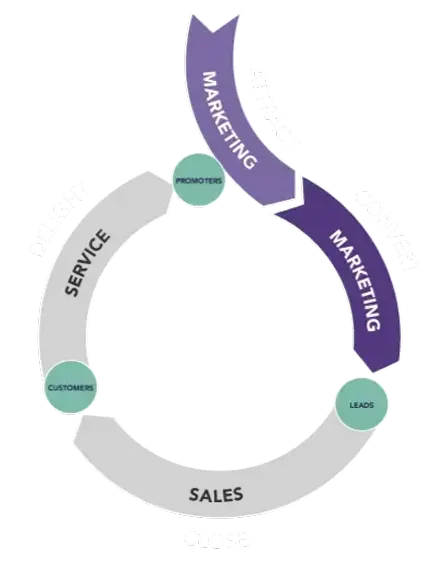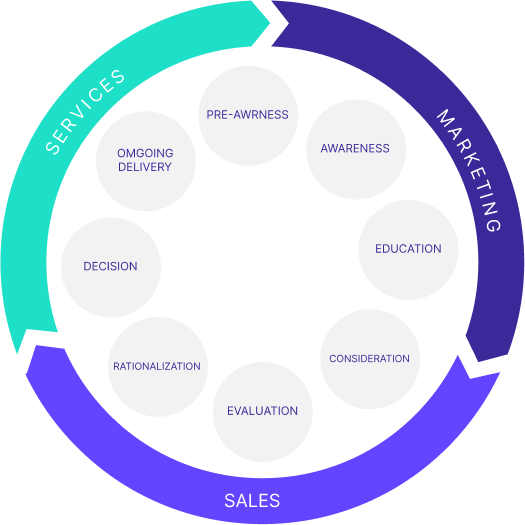


.png)


We understand Customer Experience (CX) as “the perception that customers (current and potential) have in every interaction they have with a brand.”
This has two key points regarding the client (who is the center of the strategy):
90% of customers believe that when it comes to delivering good customer experiences, most brands fail to meet their expectations.



Flywheel
The Flywheel model helps companies place the customer at the center of their strategy and focus entirely on them — becoming truly customer-centric.
It’s about making your company revolve around the client and valuing relationships, not just transactions.
Achieving business goals depends largely on strengthening the best-performing areas of your company and removing friction or bottlenecks.
In other words: amplify positive experiences and resolve the negative ones.

CX Process
We implement customer service processes through a ticketing system that gathers all case information generated daily, combined with a public knowledge base and chatbots that enable self-service for the most common inquiries.
All this is centralized in control dashboards that provide better visualization of data and process performance — measuring response times and customer satisfaction through NPS (Net Promoter Score), CSAT (Customer Satisfaction), and CES (Customer Effort Score) surveys.
We implement customer service processes through a ticketing system that gathers all case information generated daily, combined with a public knowledge base and chatbots that enable self-service for the most common inquiries.
All this is centralized in control dashboards that provide better visualization of data and process performance — measuring response times and customer satisfaction through NPS (Net Promoter Score), CSAT (Customer Satisfaction), and CES (Customer Effort Score) surveys.
All this is centralized in control dashboards that provide better visualization of data and process performance — measuring response times and customer satisfaction through NPS (Net Promoter Score), CSAT (Customer Satisfaction), and CES (Customer Effort Score) surveys.
.png)
Buyer Journey
As mentioned, the customer is at the heart of the strategy.
The analysis of our buyer personas — fictional representations of ideal customers — guides the creation and distribution of experiences.
Prospects are aligned with these personas, creating personalized contact segments based on shared interests, opportunities, and needs.
To create these profiles, we use a variety of frameworks and research methodologies tailored to each client, allowing us to gather insights regardless of context, industry, or company characteristics.
- Background
- Objectives
- Storytelling
- Marketing Message

Customer Journey
Once we understand the profile of our ideal customers, or Buyer Personas, the co-creation of a Buyer/Customer Journey aims to understand and document the process that a buyer goes through — from the moment they realize they have a need or a problem, until they become a customer and promoter of the brand.
The goal is to map the user’s behaviors, pain points, and the drivers that motivate them to move forward through each phase of the process until reaching their final decision.
This helps fulfill the objective of offering personalized and integrated experiences that meet their expectations and goals at every stage of the journey.
Buyer Personas
If the Buyer Journey defines the path the consumer takes in their purchasing decision (from their perspective), through the co-creation of the Sales Pipeline with the commercial team we are able to define the milestones that should occur throughout the process (from the company’s perspective) so that prospects ultimately become customers and the product or service is successfully delivered.
Thanks to this definition and its implementation in a CRM, it becomes possible to have full traceability of:
- The contact database at each stage.
- Conversion rates from one phase to another.
- Financial and sales forecasts or projections.
- Monitoring of goal achievement for each department and/or employee.
- The final step is to use this information to continuously optimize the strategy and improve the performance indicators.

Feedback
To measure whether the experiences created for each stage of the process are meeting their objectives and not generating friction, the best approach is to gather feedback directly from users.
To achieve this goal, three types of surveys are used:
NPS (Net Promoter Score)
It is typically measured with the question: “On a scale of 0–10, how likely are you to recommend us to a colleague?”


